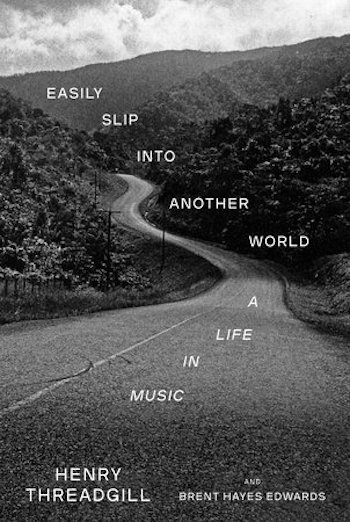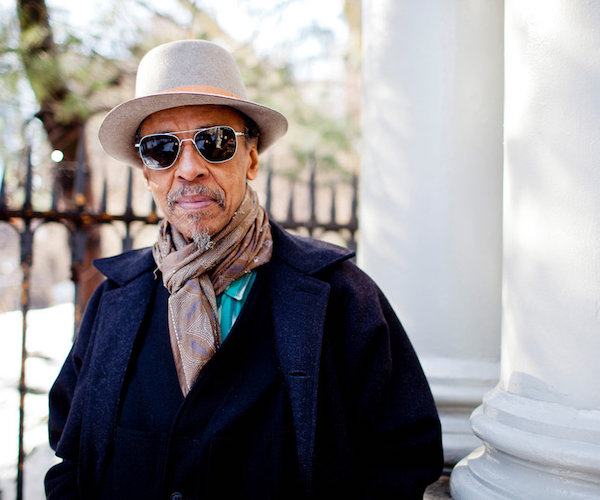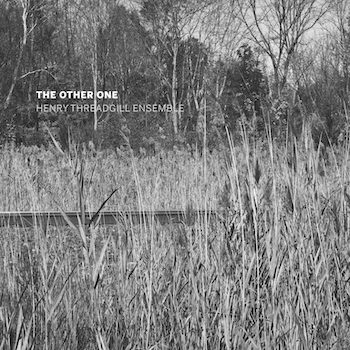Book and Jazz Album Review: Henry Threadgill Explains It All For You
By Jon Garelick
The Pulitzer Prize-winning composer eludes easy categorization, but Henry Threadgill’s new memoir — and his latest recording — take a step in defining his singular artistic personality.
Easily Slip into Another World: A Life in Music by Henry Threadgill and Brent Hayes Edwards. Knopf, 416 pages, $32.50.
The Other One (Pi Recordings), $14.
 “Damn, man, you’re just going through Webern on your own?”
“Damn, man, you’re just going through Webern on your own?”
That’s how Henry Threadgill recalls his thoughts upon seeing his colleague, the composer and trumpeter Wadada Leo Smith, poring over scores by this challenging composer of the Second Viennese School. It was 1969, and Threadgill was a just-returned 25-year-old Vietnam War vet, reacclimating himself to his hometown Chicago scene. A saxophonist well schooled in traditional jazz, and with experience touring in the troupe of a traveling preacher of a “sanctified” Pentecostal church, Threadgill found himself immersed in the experimental ferment of player/composers like Smith, Muhal Richard Abrams, Anthony Braxton, Roscoe Mitchell, Joseph Jarman, and other Chicagoans, all members of the nascent Association for the Advancement of Creative Musicians.
In another epiphany, Threadgill recalls hearing Mitchell’s seminal recording Sound: “Out of the blue he opened up an entirely new route in terms of tempo and space and silence.”
These are just a couple of revelatory moments from Threadgill’s new memoir, Easily Slip into Another World: A Life in Music (written with scholar Brent Hayes Edwards). The Pulitzer Prize-winning composer, now 79, along with members of the AACM and St. Louis’s Black Artists Group (Oliver Lake, Hamiet Bluiett, Julius Hemphill, et al.), helped expand definitions of Black music, and jazz in particular, seeing themselves as clearly part of a tradition, but also hungry for something new, trying to stake their own claim.
Never mind concepts of “swing” or blues or what we think of as jazz harmony; Threadgill and his peers took leaps outside the realms of diatonic harmony and fixed rhythms altogether. What’s more, even though they adopted much of the subversive spirit and incandescent sound worlds of the ’60s “free jazz” explosion, they were true formalists, at the same time suggesting alternative textures to the ecstatic fury of Albert Ayler, Cecil Taylor, and late Coltrane.
The new book traces this broad experimental spirit back to Threadgill’s earliest memories of growing up in a “big and noisy apartment” with an extended family that included his grandparents, mother, younger sister, “and a number of aunts, uncles, and cousins” (Threadgill’s father did not live at home). From his eccentric grandfather, Luther Pierce, Threadgill allows he may have inherited a bit of his own eccentric single-mindedness and taste for experimentation. The radio was tuned to all kinds of music, including “hillbilly.” The church his family attended hosted regular visits from Mahalia Jackson. Threadgill played the family’s piano for hours. “[No] one would say anything because they knew where I was and I wasn’t getting into trouble. I was like a cow with a bell around its neck.”
We see Threadgill’s formative music studies and his fast-growing skills as an arranger. He started going his own way early on. After volunteering for the draft, he was able to work stateside as a musician. But when his unconventional arrangement of “The Star-Spangled Banner” for a high-profile Army event roused the ire of a Catholic archbishop (“Blasphemy!”), Threadgill’s “musician” classification was quickly revised, and he was shipped off to Vietnam. “As though a musical peccadillo could merit a death sentence,” he writes. He still played plenty of music in Vietnam, but he also came under enemy fire. His description of his deployment is by turns comical and vividly harrowing.
It’s in Vietnam that Threadgill says he developed “a heightened sensitivity to sound,” in an environment where “listening can be a matter of life or death.” The transformation was profound. “[Even] if the war messed up my mind in a million other ways at the same time … I’d have to admit that that heightened sensitivity became one of the main things that shaped me into the composer I’ve become.”

Composer Henry Threadgill — album by album, his music is a wonder. Photo: John Rogers
There are a lot of elements that have contributed to the richness of Threadgill’s musical compositions, from his path-breaking trio Air to the later ensembles, the Henry Threadgill Sextett, Very Very Circus, Make a Move, Zooid, and, most recently, the Henry Threadgill Ensemble (on the new CD The Other One). (Threadgill’s commissioned writing for larger ensembles is, sadly, undocumented.) The autodidactic impulse that drove Smith to dive into Webern was common among the otherwise well-schooled members of the AACM. (Threadgill acknowledges Debussy and Edgard Varèse as particular inspirations.) But the one defining characteristic of Threadgill’s music is his attention, above all, to sound, to varied instrumental palettes and timbres.
His bands have included many great players, and each of his ensembles has been a relative success in its own way, both artistically and commercially, with media recognition and robust bookings. But it’s never too long before Threadgill feels himself “slipping,” sometimes not so easily, into another world, hearing a new music in his head that requires a new lineup — a cello, maybe, or two tubas, or two drummers. When, living in India, he decided that he needed to return to bass after the dissolution of the tuba-anchored Very Very Circus, Threadgill deputized guitarist Brandon Ross and drummer J.T. Lewis to find the right player in New York. “‘You’ll know if they fit,’ I assured them. ‘Just trust your ears. You’ll know.’” The versatile bassist Stomu Takeishi turned out to be the necessary ingredient.
By the time the book gets to his Zooid ensemble in the early aughts — Threadgill’s saxophones and flutes plus tuba, acoustic guitar, cello, drums, and Takeishi’s bass guitar — Threadgill has been adjusting sounds and procedures for decades, pushing himself into new instrumentations in pursuit of whatever he’s hearing in his head. Trying to find a legible way to organize his music, he refines his concept of motivic development, based on the interval relationships among three-note cells. Threadgill explains his system at length in the memoir, and clearly it works. Countervailing lines, short staccato statements, emerge in bursts from the different players, sometimes in unison, sometimes in opposition, and lock in. As the layers of sound develop in a Threadgill composition, they take on steam, the parts coalesce, and the piece becomes airborne — the gradual accretion of sounds at some point levitates. The ensemble becomes a hovering perpetual-motion machine.
Album by album, his music is a wonder. In 2016, Threadgill won the Pulitzer Prize for Music for Zooid’s In for a Penny, in for a Pound (Pi).
 The new The Other One, credited to the Henry Threadgill Ensemble, represents another shift — another slipping into a new sonic world: three reeds, a four-piece string section, tuba, piano, two bassoons, and Craig Weinrib on electronics and percussion. Threadgill serves as conductor (the piece was recorded as part of a multimedia performance in Brooklyn). Unusual for an ensemble under his name, he does not play.
The new The Other One, credited to the Henry Threadgill Ensemble, represents another shift — another slipping into a new sonic world: three reeds, a four-piece string section, tuba, piano, two bassoons, and Craig Weinrib on electronics and percussion. Threadgill serves as conductor (the piece was recorded as part of a multimedia performance in Brooklyn). Unusual for an ensemble under his name, he does not play.
The single piece included on the disc, “Of Valence,” is an hour long, divided into three movements, the first and last of which are divided into multiple sections as well as subsections (such as 8a and 8b). The middle movement is a self-contained 16:24.
The first movement opens with David Virelles’s solo piano, and for a few minutes I was concerned that Threadgill had slipped all the way into European modernism — isolated notes, staccato fragmentary phrases, splashes of glissando, astringent but for the relief of a passing sweet Debussyian chord, and one brief “free jazz” explosive chord cluster. It was all crafty, precisely organized, and well played, but I wondered: Where’s Henry? Had his ambitions taken him away from the singularity that made him sound like himself and no other?
Not to worry. After the first section, reeds enter, then the rest of the band. There’s a conversation among the strings, commentary from some low reeds, a piano-violin duet passage. As the piece unfolds, there are playful, jumping piano phrases, a jazzy a cappella sax passage, and angular unison passages for reeds.
The colors keep shifting, chameleon-like, and it becomes harder to isolate individual instruments — everything is as clear as a bell, but is the low brass a solo tuba or is something else in there? The playfulness is most readily apparent in Threadgill’s deployment of the two bassoons (Sara Schoenbeck and Adam Cordero), who sometimes fill out the bottom end with tuba (longtime Threadgill cohort Jose Davila) but also engage in passages of antiphonal parrying (much like the dual tubas in Very Very Circus).
There are lovely quiet passages of stasis (“tempo and space and silence”), but mostly it’s all moving all the time, with beautifully calibrated shifts among voices and Threadgill’s own concept of knotty groove and funk. The only thing I missed at first was Threadgill’s tart alto saxophone, but with so much going on in this music — and three capable reed players in Alfredo Colón, Noah Becker, and Peyton Pleninger — it was easy to slip with Threadgill into his latest world.
Jon Garelick regularly writes about jazz for the Arts Fuse, Boston Globe, and other publications. He can be reached at garelickjon@gmail.com.
Tagged: Easily Slip into Another World: A Life in Music, Henry Threadgill, PI Recordings

Wow, great read and job capturing the essence and spirit of Henry Threadgill. Looking forward to checking out the book and record.
Jon, I would marvel at jazz articles like this by you in the late Boston Phoenix. It’s such a pleasure to read an essay bringing in play your astonishing jazz and music expertise in the Fuse. Nice nice piece!